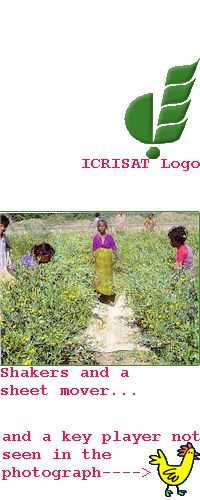|
|
|||
An ancient weapon slays pod borers in pigeon peas. |
|||
|
When India's breathtaking Green Revolution in 1960s had delivered the land beyond the reach of famine, sober minds began to consider the road ahead. The agricultural revolution had in fact been world wide, brought on by high yielding seeds and fertiliser inputs. The global revolution had been spear-headed by four institutions: CIAT [in Colombia], CIMMYT [in Mexico], IITA [in Nigeria] and notably for India, IRRI [International Rice Research Institute, Manila, Philippines]. The emerging issue at hand was sustainability of the successes. The concern led to the creation in 1971 of CGIAR [Consultative Group on International Agricultural Research] backed by the World Bank and several governments. CGIAR began as a hub for connecting the above four institutions and has since grown into a huge network. [You can read the CGIAR story here. ] The grain revolution needed to be broadened to address other crucial areas: pulses, vegetables, oilseeds, dairy, nutrition, empowerment, participation and so on. The upshot was a series of Future Harvest Centers under the aegis of CGIAR. Today there are 16 around the world. ICRISAT [International Crops Research Institute for the Semi Arid Tropics], one of those Centers, was the gift to India. Established in Hyderabad in 1972, ICRISAT has been living up to its name. It has observed India's farm scene, found lacunae and intervened with state of the art research. More laudably, ICRISAT has also walked behind India's ancient farmer and paid heed to his wise ways. Over 5000 years of human habitation on this Indian sub-continent cannot have been possible, if its farmers had not been industrious and innovative. What follows is an excerpt from the ICRISAT site . It is a heart-warming story of scientists and Indian farmers interacting and exchanging knowledge. It is reproduced here courtesy the express permission set out at the ICRISAT site. This story's presence here is also due to the tip sent by Mr. Anand Mulgund, a well-wisher of GoodNewsIndia's mission. Recovering Indigenous Knowledge: The Pigeonpea Shake-Down Eighty-year-old Mr Bitchappa's advice was almost easy beyond belief: shake the infamous podborers off pigeonpea plants, and save US$ 310 millions annually , the estimated worldwide pigeonpea crop losses due to the podborer Helicoverpa. Mr Bitchappa's fellow farmers in Hamsanapalli village, in Mahabubnagar district of Andhra Pradesh (AP), had come to him because pigeonpea losses in their village were becoming intolerable -- between 20 and 100 percent of their crops were lost to the deadly podborer. Over 4 million ha worldwide, mainly in southern Asia and eastern Africa, are under pigeonpea. This grain legume is a major source of inexpensive protein (20%), fodder, and fuel in the tropics and the subtropics. By 1993, 100% of pigeonpea farmers were using chemical control in India. Applying 3-6 sprays of chemicals became common practice. While this worked fine to start with, soon yields began to decline, and the high insecticide investment began to hurt farmers. Enter Mr Bitchappa. A party for chickens: In a farmer-participatory discussion organized in Mr Bitchappa's village by the NGO, Research in Environment, Education and Development Society (REEDS), the village elder recalled how, in the pre-insecticide days, pigeonpea plants were gently shaken, and podborer larvae dropped off the plants. The larvae were collected in a sheet which was dragged along the ground in the interspace between rows of pigeonpea plants. A few hens were allowed to follow this sheet, and the plump worms provided a high-protein feast for the voracious birds! However, private agencies were skeptical about the applicability, efficiency, and economics of this 'shake-down' technique. So, during the 1998-1999 season, this indigenous technology was evaluated in a 15-ha research watershed at ICRISAT-Patancheru, with support from IFAD and in collaboration with ICAR, ANGRAU, MAU, and NGOs under the coordination of CWS. Spreading the message: The results were spectacular: when plants were 'shaken down' an 85% reduction in insect population was achieved, while the larval population in the adjacent, chemically sprayed plots remained high throughout the cropping period. The 'pigeonpea shake-down' wins hands down on the cost-front too: it costs just Rs 280 (US $ 6) per hectare to have 7 people to shake pigeonpea plants, and collect larvae; and each chemical spray costs Rs 500-700 (US $ 11-16) per hectare. This technology, initiated at a few locations during 1997, rapidly spread to more than 100 villages involving several thousand farmers in three states of southern India within 2 years. All these farmers continue to use the method. "We are working with farmers, NGOs to include this simple indigenous cultural practice as a critical component of our IPM strategy for pigeonpea," says ICRISAT entomologist G V Ranga Rao. A fuller -- and more technical-- version of this story may be found at this link. November,2001
|
|
||

